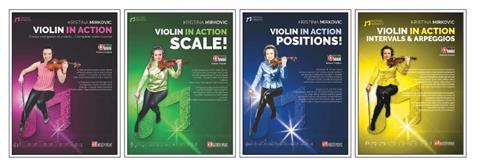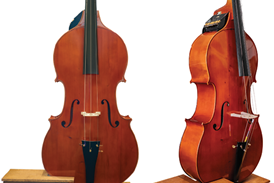Celia Cobb reviews Kristina Mirkovic’s four-volume course on violin playing, including books on scales, positions, and intervals and arpeggios

Violin in Action
Kristina Mirkovic
Book 1: 88PP ISBN 9788832008173
Book 2 (Scale): 88PP ISBN 9788832008623
Book 3 (Positions): 86PP ISBN 9788832008876
Book 4 (Intervals/Arpeggios):
186PP ISBN 9791281535053
Dantone Edizioni
Violin in Action is a set of four volumes developed by Serbian violinist Kristina Mirkovic, designed to be used either as stand-alone method books or in connection with ‘Metodo Mirkovic’, an online violin school where lessons can be accessed by subscription or one-off payments. Each book offers a wealth of supporting material in the form of very detailed photographs, as well as links to online teaching and demonstration performance videos on YouTube.
Book 1, ‘Complete violin course’, undertakes a thorough exploration of basic bow division. Twenty-four different possibilities for dividing the bow are covered, including division in quarters, thirds and halves as well as in dotted rhythms, syncopation and compound/unusual time signatures, rather like a modern and user-friendly version of Ševčík op.2 for the 21st-century student. The next part of the book turns attention to the left hand, with a relatively brief presentation of the basic 0 1 2-3 pattern followed by many further exercises, each with a new combination of finger patterns, until all first-position options have been exhausted. Having worked through all the bowing and finger-pattern exercises, the student arrives at ‘Song 1’, the first of the 15 folk tune arrangements in the book. The previously learnt bow divisions and finger patterns are indicated in the text above the music, and reinforced in the accompanying YouTube video.
Book 2, ‘Scale!’, begins with a refresher course in the finger patterns previously presented in the first volume, explanations of the circle of 5ths, and a quick presentation of fourth-finger extensions. Again, the bulk of the first section of the book focuses on bow division then, after completing the 44 bowing variations, the student may move to playing tunes; there are 24 folk song arrangements, one for each major and minor key. Each tune is preceded by an outline of the first position notes in that key, with corresponding photographs and indications of the finger patterns. Eighteen further finger patterns are identified and labelled as part of this process.
In book 3, ‘Positions!’, attention turns to the business of shifting. First to be covered is third position, with shifts from first to third and back, and various finger pattern exercises (including extensions) followed finally by folk songs in third position on all strings. Second and fourth positions are covered in a similar way, and the remainder of the book focuses on shifting to and from different fingers within third, second and fourth positions.
Book 4, ‘Intervals and Arpeggios’, begins with a comprehensive chart (including photographs and finger pattern identification) of all first-position major and minor scales. Next comes a series of increasingly complex bowing exercises, before a gargantuan section on double-stopped intervals (each with its own photograph) and double-stopped scales in first position, all written out in full. Arpeggios, including inversions, are also covered before selected tunes from previous books are presented with the addition of double-stops. The book finishes with exercises covering all intervals from a 3rd to an octave on both the same and adjacent strings in first to fourth positions. This book has more of the feel of a manual for advanced students rather than a tutor book aimed at those in the early stages of playing.
Overall, this series contains a wealth of useful and interesting Serbian repertoire to explore, and one of the most interesting aspects of the book is the chance to explore tunes with time signatures of 7/8, 11/8 and 9/8 (as 2+2+2+3). There are unfortunately no accompaniment-only or piano backing tracks available for any of the folk tunes, and it is worth noting that while the Book 1 videos are available in either English or Italian versions, the videos for the later books are bilingual, so non-Italian speakers will need to fast forward to the English sections – timings are, helpfully, clearly indicated in the notes.
Read: 10 tips for learning and teaching sightreading
Read: Music teacher vs instrumental tutor: is there a difference?
Analysis August 2023: Changing teaching approaches for adult beginners
The series is written by a violinist who is clearly passionate about precision and preparation. The books seem to be aimed at children but might be more suited to the earnest teenage or adult beginner, perhaps those coming to the violin as a second instrument, who would embrace the discipline of attending to hardcore technical work from the outset, without being patronised by cutesy cartoons and nursery repertoire. I fear that the majority of my students (aged four to teenage) would go on strike if I insisted that they work through weeks or months of exercises before being let loose on a tune. But I am sure that any students who are dedicated and determined enough to work through the exercises in these volumes from beginning to end, aided by the many online videos, will find that their knowledge and understanding of bow divisions and finger patterns, as well as Serbian folk music, will be second to none.
CELIA COBB









































1 Readers' comment